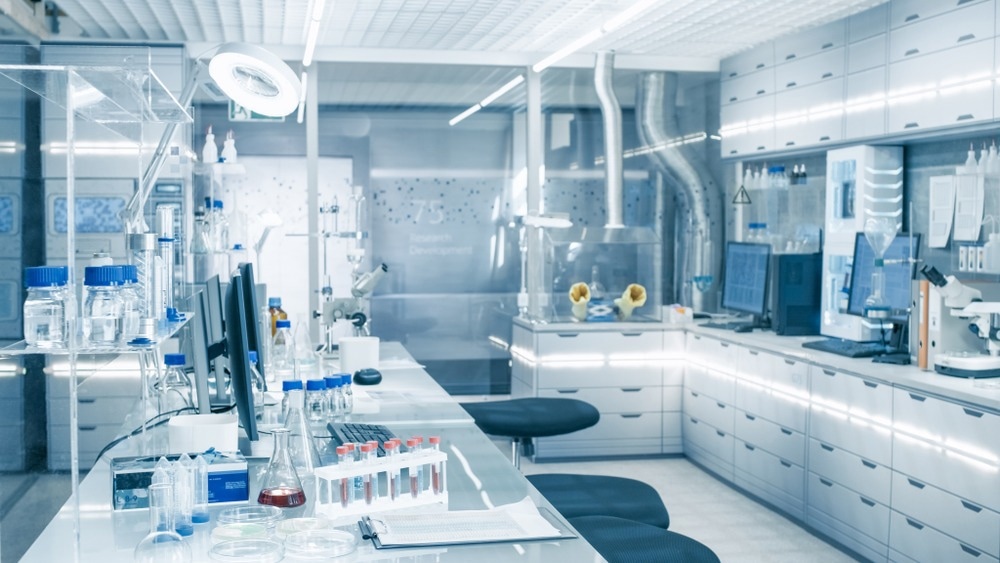Here, we explore the development of laboratory robots designed for electrochemistry applications. We take a deep dive into a highly adaptable open-source device recently developed by the Rodriguez-Lopez research group at the Beckman Institute for Advanced Science and Technology (BIAST).

Image Credit: Gorodenkoff/Shutterstock.com
Laboratory robots are increasingly employed in the performance of repetitive and mundane tasks in manufacturing and research, particularly those that also require precise and complex manipulation and sensitive data collection.
Various forms of autosamplers are already commonplace in most mid-size laboratories, and certain fields make more extensive use of robots than others at larger scales, such as the pharmaceutical industry for the purposes of nuclear magnetic resonance and mass spectrometry sample preparation, cell dose-response testing, drug manufacture, and other specific uses.
The field of electrochemistry is similarly seeing robots become increasingly useful as huge quantities of comparison data are required for the optimization of electronic devices such as batteries and solar cells, tasks most suited to the highly precise but repetitive movement of robots.
How Does the Electrolab work?
Researchers at the BIAST announced in November 2023 that they had developed a laboratory robot able to run complex electrochemistry experiments and even collect and analyze the output data.
The robot, titled the Electrolab, is benchtop-suitable and designed for affordability and accessibility, and it can handle a variety of repetitive electrochemistry tasks. The structure of the device is similar to that of an FDM 3D printer, where several motors are able to precisely control the positioning of the head in three dimensions above a configurable number of cells.
The head contains an electrode array, dispensing, and cleaning functions, allowing the device to automatically dispense solutions and take readings. Part of the dispensing and cleaning apparatus is the argon gas nozzle, which is used to sparge (remove gas from the sample) and then to dry the electrochemical cell.
The team used just two more nozzles for dispensing and cleaning, respectively, though almost any number more could be used to deliver incompatible materials.
Similarly, devices such as pH probes and manipulative arms could be attached to the head to further improve the utility of the automated laboratory robot. Three solution lines fed individually by peristaltic pumps were incorporated into the single dispensing head, and the connecting line was flushed between dispenses to prevent cross-contamination.
The rinsing nozzle was designed not only to rinse the electrode and electrochemical cell but also with a suction function to remove the solution following testing, preparing the cell for the next experiment. In all, the device is expected to cost around $1,000 to build, putting it into the price range of small laboratories with some technical know-how.
The software behind the Electrolab was created in Python, allowing code-competent users to set up their experimental procedures. In the associated paper published by the research group, the device performed 200 experiments with varying conditions, analyzed the data, and cleaned itself within two hours, which the team claims would have taken a human operator closer to eight.
Specifically, Electrolab used the Randles–Ševčík equation and performed a simple proof of principle experiment on the well-known redox species FcMeOH. Two solutions containing 1 mM FcMeOH and 100 mM KNO3-supporting electrolyte, and one solely of 100 mM KNO3, were dispensed, and an electrode array consisting of eight 200-μm diameter electrodes was utilized to perform cyclic voltammetry at five concentrations, five scan rates, one electrode at a time, for 200 total experiments.
Novel Electrochemistry Robots
Other types of laboratory robots intended to assist in specific electrochemical experiments have been developed by other research groups. For example, Godfrey et al. (2016) produced an electrochemical analysis array to identify leaching materials.
The device bears a large sample array of 180 chambers in which they can be submerged in solvent, and similarly to the Electrolab, a motorized header bearing an electrode array is mounted on an x-y-z frame and thus is able to position itself over any of the sample chambers.
Many forms of biosensors are based on electrochemical principles, most prominently glucose blood concentration sensors, wherein immobilized glucose oxidase enzyme catalyzes the oxidation of glucose in the patient’s blood, which ultimately leads to the generation of hydrogen peroxide and the transfer of two electrons at the electrode surface as the molecule breaks down.
Glucose biosensors based on this reaction are becoming increasingly convenient as wearable or implantable devices and may incorporate other functions, such as automated insulin administration. A variety of similar electrochemical analysis set-ups can be incorporated into Electrolab and similar devices, should the appropriate electrodes and electrochemical cells be incorporated.
Enzyme dependant reactions such as this may bear some specialized requirements for their maintenance over other electrochemical experiments, namely continuous submersion in buffer solution and likely more frequent replacement, but could be employed in high-throughput diagnostic settings.
Conclusion
Laboratory robots typically offer faster processing and improved repeatability and reproducibility over human operators, as mistakes associated with the handling of liquid and solid compounds are lessened. Robots are also more efficient, as they can work continuously as long as they are properly maintained. On the other hand, automated robot assemblies can be expensive to construct and maintain initially, and many specific techniques may not even be suitable for automation.
References and Further Reading
Oh, I., et al. (2023). The Electrolab: An open-source, modular platform for automated characterization of redox-active electrolytes. Device, 1(5). doi.org/10.1016/j.device.2023.100103
Godfrey, D., et al. (2016). A robotic platform for high-throughput electrochemical analysis of chalcopyrite leaching. Green Chemistry, 18(7), pp. 1930–1937. doi.org/10.1039/c5gc02306h
Yoo, E.-H. & Lee, S.-Y. (2010). Glucose Biosensors: An Overview of Use in Clinical Practice. Sensors, 10(5), pp. 4558–4576. doi.org/10.3390/s100504558
Disclaimer: The views expressed here are those of the author expressed in their private capacity and do not necessarily represent the views of AZoM.com Limited T/A AZoNetwork the owner and operator of this website. This disclaimer forms part of the Terms and conditions of use of this website.